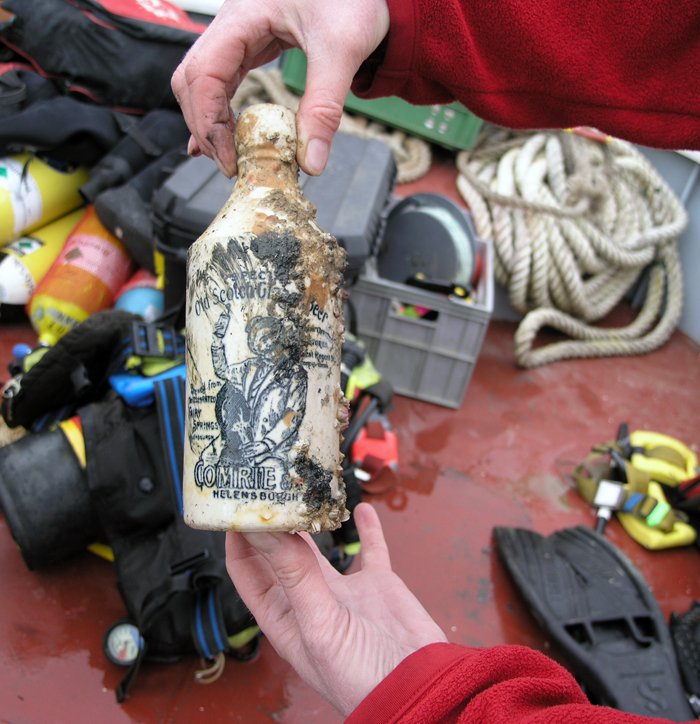In addition to the wealth of shipwrecks around the Solent and the Isle of Wight there is also evidence of the mooring of ships in this favoured area for anchoring. Weather, tidal conditions and associated shore side settlement or facilities often mean ships seek suitable areas to moor up and/or drop anchor. With the shelter provided by the Isle of Wight and suitable seabed conditions the Solent has been used for this from the Roman period onwards.
While at anchor a surprising amount of material is either lost over board or deliberately jettisoned. This has left a legacy of anchorage related material on the seabed. To date there have been few detailed studies of these sites, meaning their full archaeological importance is not always recognised.
The MAT is researching these sites through field investigations and associated research. The Dive onto Victory project (see below), in particular, has been important in demonstrating the density and diversity of an anchorage collection. This is just one of many anchorage sites in the Solent. The long history of the naval use of Spithead has left a range of seabed traces as has the use of many of the smaller anchorages such as Yarmouth and Ryde Roads. Some of these known historic anchorages were investigated in the 1990s in a pioneering project to use controlled trawls to recover material.
In addition to the archaeological evidence there are a variety of historical sources, which can add to our understanding of these sites. The use of historic charts, sailing directions and paintings can add a new dimension to research.
The development of historic anchorages is linked to particular geographical, environmental and cultural factors, which have all had an impact on the archaeological material on the seabed. The international nature of ships and shipping means a range of social, political and economic factors are reflected in the collections the ships leave behind. To investigate these aspects work is ongoing to identify comparative collections from around the globe.
The Dive onto Victory Project was initiated to commemorate the 200th anniversary of the Battle of Trafalgar and associated ‘Sea Britain 2005’ activities. This initial work was contributed to by the Friends of the HWTMA and supported by funding from the Heritage Lottery Fund Local Heritage Initiative. Further investigation and research has helped to develop understanding of the archaeological potential of historic anchorage sites.
Between 2005 and 2007 diving investigation gathered information from a number of sites within Portsmouth Harbour where HMS Victory had been moored after its active service. One site in particular, on the Gosport side of the Harbour, proved to be significant and, after survey, a collection of over 250 artefacts was recovered from the surface of the seabed. This mooring area is well documented on charts and photographs (the earliest being from 1897), and is important as it has not been subject to modern disturbance.
In addition to the archaeological investigations the project also sought to collect oral histories related to working on or with the sea. This information was used to contribute to a range of displays and activities.
Dive onto Victory Artefacts
The mooring site on the Gosport side of the harbour was surveyed by divers. An area of around 30m by 30m was examined in detail. The team were surprised by the number of artefacts that were present on the seabed. Drawings and photographs were taken prior to the recovery of artefacts.
The collection of 257 artefacts consists of a range of types of artefact. The collection is dominated by ceramics and glass, most of which dates from 1750 onwards. This material is providing an important insight into life onboard naval vessels over the past 200 years in addition to adding to understanding of the form and distribution of archaeological material on anchorage sites.
A selection of the artefacts was on display in Southampton’s new SeaCity Museum as part of their “Titanic The Legend” exhibition (August 2013), and more artefacts from the project are now due to be on display at the National Museum of the Royal Navy.

As the home of the Royal Navy, Spithead has been a key anchorage for hundreds of years. The mooring of vessels has left a legacy of buoyage infrastructure in addition to the wrecks of some of the vessels themselves, such as the Royal George and Boyne.
As well as the naval focused area around Portsmouth Harbour, the Solent has a large number of other anchorage sites, many of which have associated seabed material. Current research is gathering information from historic charts and any available recoveries of objects or collections from in and around the Solent to help develop understanding of these sites.
This work can also draw on the results of an innovative project undertaken in the 1990s which responded to reports from local fishermen with controlled trawls in areas of the known historic anchorages of Ryde Roads, Mother Bank and off the Medina Estuary. Although this project was seeking evidence from Roman ships and shipping during the two day trawl virtually all the material recovered was post-Medieval in date.
